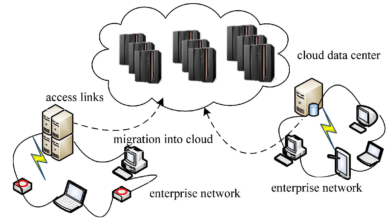Enhancing Accessibility with Data Servers
In today’s digital world, enhancing accessibility has become a top priority for businesses and organizations across various industries. With the increasing reliance on data and technology, data servers play a crucial role in ensuring seamless accessibility and efficient operations. In this blog article, we will delve into the world of data servers and explore how they can enhance accessibility for businesses and individuals alike.
First and foremost, let’s understand what data servers are. Data servers are powerful machines or software systems that store, manage, and process vast amounts of data. They act as a central hub for storing and retrieving data, making it easily accessible to users or applications. By leveraging data servers, businesses can ensure that their data is readily available and accessible to authorized users, regardless of their physical location or device they are using.
The Importance of Data Servers in Accessibility
In today’s fast-paced business environment, accessibility is crucial for organizations to remain competitive and meet the needs of their users. Data servers play a vital role in enhancing accessibility by providing a reliable and secure platform for storing and accessing data. Let’s explore some key reasons why data servers are essential in ensuring accessibility:
Seamless Connectivity and Collaboration
Data servers serve as a central hub for storing and retrieving data, enabling seamless connectivity and collaboration among employees, teams, and departments. By having a centralized data server, businesses can ensure that authorized users can access the information they need, regardless of their physical location or time zone. This enhances accessibility for remote workers, enabling them to work efficiently and access critical information from anywhere in the world.
Reliable Data Storage and Retrieval
Data servers provide businesses with reliable and secure storage for their data. By storing data on dedicated servers, organizations can ensure that their information is protected from data loss or unauthorized access. This reliability and security contribute to enhancing accessibility by ensuring that data is always available when needed, without the risk of downtime or data breaches.
Scalability and Flexibility
As businesses grow and their data needs increase, data servers offer scalability and flexibility. Organizations can easily expand their server capacity to accommodate the growing demands of their users. This scalability ensures that data remains accessible, even as the volume of data and the number of users accessing it increase over time. Additionally, data servers provide flexibility in terms of access, allowing authorized users to retrieve and interact with data using various devices, such as laptops, tablets, or smartphones.
Efficient Data Processing
Data servers are equipped with powerful processing capabilities, enabling efficient data processing and retrieval. With the ability to handle large volumes of data, data servers ensure that users can access information quickly, without experiencing delays or performance issues. This efficiency in data processing contributes to enhanced accessibility by providing a seamless and responsive user experience.
Ensuring Data Accessibility for Remote Workforce
In recent years, remote work has become increasingly popular, and businesses need to ensure that their remote workforce has seamless access to data. Data servers play a crucial role in enabling data accessibility for remote workers. Let’s explore how data servers facilitate accessibility for remote workforce:
Remote Access to Data Servers
One of the key ways data servers enhance accessibility for remote workers is by enabling remote access to the server and its stored data. Remote access allows employees to securely connect to the data server from any location, using their authorized credentials. This enables them to access files, documents, and applications stored on the server, as if they were physically present in the office. By providing remote access to data servers, businesses can ensure that their remote workforce has the same level of access and productivity as their in-office employees.
Collaboration and Communication
Data servers also facilitate collaboration and communication among remote workers. With shared access to data stored on the server, remote employees can collaborate on projects, share files, and communicate in real-time. This enhances accessibility by fostering seamless collaboration regardless of geographical barriers. Remote workers can contribute to projects, provide feedback, and stay connected with their colleagues, ensuring accessibility to information and fostering a sense of teamwork and productivity.
Backup and Recovery for Data Security
Data servers provide backup and recovery capabilities, ensuring the security and accessibility of data for remote workers. By regularly backing up data stored on the server, businesses can protect against data loss due to hardware failures, natural disasters, or human error. In the event of data loss, remote workers can rely on the server’s backup to restore their files and continue their work without interruption. This backup and recovery functionality not only enhances accessibility but also provides peace of mind for both businesses and remote workers.
Improving Accessibility for Persons with Disabilities
Enhancing accessibility is not just about providing access to data; it also involves creating inclusive environments for individuals with disabilities. Data servers can contribute to improving accessibility for persons with disabilities in several ways. Let’s explore how data servers enhance accessibility for individuals with disabilities:
Supporting Assistive Technologies
Assistive technologies, such as screen readers, braille displays, and speech recognition software, play a crucial role in enabling individuals with disabilities to access information. Data servers can support these assistive technologies by ensuring that the data stored is compatible and accessible through these tools. By implementing accessibility features, such as proper labeling of content and structured data formats, data servers can enhance accessibility for persons with visual impairments, cognitive disabilities, or mobility limitations.
Providing Alternative Data Formats
Data servers can also enhance accessibility by providing alternative data formats for individuals with disabilities. For example, individuals with visual impairments may require data in audio or tactile formats to access information effectively. Data servers can store and distribute data in multiple formats, allowing individuals to choose the format that suits their needs best. This flexibility in data formats ensures that individuals with disabilities can access and interact with information on their own terms, ensuring equal opportunities for participation.
Ensuring Compatibility with Accessibility Standards
Accessibility standards, such as the Web Content Accessibility Guidelines (WCAG), provide guidelines and best practices for creating accessible digital content. Data servers can play a role in enhancing accessibility by ensuring compatibility with these standards. By adhering to accessibility guidelines, data servers enable businesses to provide accessible data and content to individuals with disabilities. This includes considerations such as proper text alternatives for images, keyboard accessibility, and clear navigation structures.
Enhancing Website Accessibility with Data Servers
Websites are an essential medium for businesses to interact with their audience, and website accessibility is a crucial aspect of ensuring inclusivity. Data servers can contribute to enhancing website accessibility in several ways. Let’s explore how data servers play a vital role in improving website accessibility:
Efficient Content Delivery
Data servers enable efficient content delivery, ensuring that websites load quickly and are accessible to users with various internet connection speeds and devices. By storing website content on data servers strategically located around the world, businesses can reduce latency and deliver content to users more efficiently. This enhances website accessibility by providing a seamless browsing experience, regardless of the user’s location or internet capabilities.
Content Distribution Networks (CDNs)
Content Distribution Networks (CDNs) are a network of servers distributed across different geographic locations. CDNs work together with data servers to enhance website accessibility by optimizing content delivery. CDNs store cached versions of website content on multiple servers, reducing the distance between the user and the server. This reduces latency and ensures faster content delivery, contributing to an improved user experience and enhanced accessibility.
Load Balancing for Scalability
Data servers facilitate load balancing, which ensures that website resources are allocated efficiently among the users. Load balancing distributes incoming traffic across multiple servers, preventing any single server from becoming overwhelmed. This scalability ensures that websites remain accessible, even during periods of high traffic. By efficiently managing resources, data servers contribute to enhanced website accessibility and a seamless browsing experience for users.
Streamlining Data Accessibility through Cloud Servers
Cloud servers have revolutionized the way businesses store and access their data. By leveraging cloud-based data servers, organizations can streamline data accessibility and enhance their operations. Let’s explore how cloud servers contribute to enhancing data accessibility:
Scalability and Elasticity
One of the key benefits of cloud servers is their scalability and elasticity. Cloud servers can easily accommodate the growing demands of businesses by providing additional resources on-demand. This scalability ensures that data remains accessible, even as the volume of data and the number of users accessing it increase. Cloud servers also offer elasticity, allowing businesses to scale resources up or down based on their specific needs, ensuring optimal performance and accessibility.
Global Accessibility
Cloud servers enable global accessibility by distributing data across multiple regions. This ensures that data is stored closer to the users, reducing latency and enabling faster access to information. Users from different parts of the world can access the same data with minimal delay, enhancing accessibility and providing a consistent user experience. Cloud servers also offer geo-redundancy, where data is replicated across multiple data centers, ensuring high availability and accessibility even in the event of a localized outage.
Collaboration and Remote Work
Cloud servers facilitate collaboration and remote work by providing seamless access to data from anywhere with an internet connection. With cloud-based data servers, remote workers can access and collaborate on files in real-time, regardless of their physical location. This enhances accessibility for remote workers, enabling them to work efficiently and contribute to projects as if they were physically presentin the office. Cloud servers also offer advanced collaboration features, such as version control and real-time editing, which further enhance accessibility and streamline remote work processes.
Data Servers and the Internet of Things (IoT)
The Internet of Things (IoT) has transformed the way we interact with technology, and data servers play a crucial role in managing and processing the massive influx of data generated by IoT devices. Let’s explore how data servers and IoT intersect to enhance accessibility:
Real-Time Data Processing
IoT devices generate a vast amount of real-time data that requires immediate processing and analysis. Data servers with powerful processing capabilities can efficiently handle this data, ensuring accessibility to valuable insights in real-time. This enables businesses to make informed decisions promptly and respond to changing conditions, enhancing accessibility to critical information for various applications, such as smart cities, healthcare monitoring, and industrial automation.
Data Integration and Interoperability
Data servers act as central repositories for IoT-generated data, facilitating data integration and interoperability. By integrating data from multiple sources, businesses can gain a holistic view of their operations and make data-driven decisions. Data servers ensure the accessibility of integrated data by organizing it in a structured and standardized manner, making it easier to retrieve and analyze. This enhances accessibility to comprehensive insights and fosters seamless collaboration among different IoT devices and systems.
Data Security and Privacy
With the proliferation of IoT devices, data security and privacy have become paramount concerns. Data servers play a crucial role in ensuring the accessibility and protection of IoT-generated data. By implementing robust security measures, such as encryption, access controls, and authentication protocols, data servers safeguard the accessibility and integrity of sensitive information. Additionally, data servers enable businesses to comply with privacy regulations and standards, ensuring that data collected from IoT devices is handled ethically and securely.
Ngadsen test2
Ensuring Data Security and Accessibility
Ensuring data security is essential for maintaining accessibility and building trust among users. Data servers can implement various measures to enhance both data security and accessibility. Let’s explore some key strategies for ensuring data security and accessibility:
Authentication and Access Controls
Implementing robust authentication mechanisms and access controls is crucial for ensuring data security and accessibility. By requiring authorized credentials for accessing data servers, businesses can prevent unauthorized access and protect sensitive information. Access controls can be granular, allowing businesses to define different levels of access for different users or user groups. This ensures that data remains accessible only to authorized individuals or applications, enhancing both security and accessibility.
Data Encryption
Data encryption plays a vital role in ensuring the confidentiality and accessibility of sensitive information. By encrypting data stored on data servers, businesses can protect it from unauthorized access or interception. Encryption algorithms ensure that data can only be accessed with the correct decryption keys, ensuring that even if the data is compromised, it remains inaccessible to unauthorized parties. This robust encryption enhances both data security and accessibility, as authorized users can decrypt and access the data as needed.
Regular Backups and Disaster Recovery
Regular backups and disaster recovery plans are crucial for ensuring data accessibility and mitigating the impact of unforeseen events. Data servers should have automated backup processes in place to regularly create copies of data, ensuring that it can be restored in the event of data loss or corruption. Disaster recovery plans outline the steps to be taken to restore data and operations in the event of a disaster, such as a natural calamity or a cyberattack. By implementing effective backup and recovery strategies, businesses can ensure the accessibility and continuity of critical data.
Monitoring and Intrusion Detection
Data servers should be equipped with robust monitoring and intrusion detection systems to identify and respond to any potential security breaches. Monitoring systems track access patterns and activities on the server, allowing businesses to detect any suspicious or unauthorized behavior. Intrusion detection systems can identify and alert businesses to potential threats, such as unauthorized access attempts or unusual data transfers. By actively monitoring and detecting security threats, businesses can take immediate action to mitigate risks and ensure the accessibility and security of their data.
Data Servers in Healthcare for Enhanced Accessibility
Accessibility is crucial in the healthcare industry, where timely access to patient information and collaboration among healthcare professionals can directly impact patient care. Data servers play a vital role in enhancing accessibility in healthcare. Let’s explore how data servers contribute to improved accessibility in the healthcare industry:
Seamless Sharing of Medical Records
Data servers enable the seamless sharing and accessibility of medical records among healthcare professionals. By storing patient records on data servers, healthcare providers can ensure that authorized personnel can access patient information quickly and securely, regardless of their physical location. This enhances accessibility to critical medical data, enabling better coordination of care and timely decision-making.
Interoperability and Data Exchange
Data servers facilitate interoperability and data exchange among different healthcare systems, such as electronic health record (EHR) systems, laboratory information systems, and medical imaging platforms. By implementing standardized data formats and protocols, data servers enable the seamless exchange of patient information, enhancing accessibility across different healthcare settings. This interoperability ensures that healthcare professionals can access and share relevant patient data, leading to improved care coordination and enhanced accessibility to comprehensive medical information.
Remote Consultations and Telemedicine
Data servers play a crucial role in enabling remote consultations and telemedicine services, enhancing accessibility to healthcare for patients, especially in remote or underserved areas. By leveraging data servers, healthcare providers can securely transmit patient data, including medical images and test results, to remote healthcare professionals. This enables remote consultations and telemedicine services, ensuring that patients can access healthcare services without the need for physical travel. Data servers facilitate the accessibility of patient information and enable real-time communication between healthcare providers and patients, enhancing access to healthcare services.
The Future of Data Servers and Accessibility
Data servers and accessibility will continue to evolve hand in hand as technology advances. The future holds exciting possibilities for data servers and their role in enhancing accessibility. Let’s explore some emerging trends and technologies that will shape the future of data servers and accessibility:
Artificial Intelligence and Machine Learning
Artificial intelligence (AI) and machine learning (ML) technologies are poised to transform data servers and accessibility. AI algorithms can analyze vast amounts of data stored on data servers, providing valuable insights and predictive capabilities. This enhances accessibility by enabling businesses to leverage data-driven decision-making and automation. ML algorithms can also optimize data server operations, improving performance, and ensuring efficient data accessibility for users.
Edge Computing
Edge computing is an emerging paradigm that brings data processing closer to the source of data generation. By deploying data servers at the edge of the network, closer to IoT devices or end-users, businesses can reduce latency and enhance data accessibility. Edge computing enables real-time processing and analysis of data, ensuring timely access to critical information. This technology has the potential to revolutionize accessibility, particularly in applications that require low latency and high responsiveness, such as autonomous vehicles or augmented reality.
Blockchain Technology
Blockchain technology has gained significant attention for its potential to revolutionize data security and accessibility. By utilizing distributed ledger technology, data servers can enhance accessibility by providing transparent and tamper-proof records. Blockchain can enable secure and auditable access to data, ensuring its integrity and accessibility for authorized users. This technology has the potential to enhance accessibility while maintaining data security and privacy, particularly in industries such as finance, supply chain management, or healthcare.
Best Practices for Optimizing Data Server Accessibility
Optimizing data server accessibility is crucial for ensuring seamless data access and a positive user experience. Here are some best practices to enhance data server accessibility:
Implement Robust Data Governance
Establishing robust data governance practices ensures that data stored on data servers is organized, accurate, and accessible. This includes implementing data quality controls, defining data ownership and accountability, and establishing data management policies. Robust data governance enhances accessibility by ensuring that data is reliable, consistent, and easily retrievable.
Regularly Monitor and Optimize Performance
Monitoring and optimizing data server performance is essential for maintaining accessibility. Regularly monitor server performance metrics, such as response times, throughput, and resource utilization. Identify any performance bottlenecks and take proactive measures to optimize server performance. This ensures that data remains accessible in a timely manner and contributes to a seamless user experience.
Conduct Regular Security Audits
Regular security audits are critical for maintaining data server accessibility and protecting against potential threats. Conduct comprehensive security audits to identify any vulnerabilities or weaknesses in the server’s security infrastructure. Implement necessary security measures to address any identified risks and ensure that data remains accessible only to authorized users.
Stay Abreast of Accessibility Standards and Guidelines
Accessibility standards and guidelines, such as the Web Content Accessibility Guidelines (WCAG), provide a framework for creating accessible digital content. Stay updated with the latest accessibility standards and guidelines to ensure that data stored on data servers complies with these requirements. Implement accessibility features, such as proper labeling of content, keyboard accessibility, and alternative text for images, to enhance data server accessibility.
In conclusion, data servers play a vital role in enhancing accessibility in today’s digital landscape. By providing reliable and secure access to data, supporting remote work, and enabling inclusive practices, data servers empower businesses and individuals to thrive in an accessible and interconnected world. As technology continues to advance, data servers will continue to evolve, ensuring that accessibility remains at the forefront of digitalinnovation. The future holds exciting possibilities for data servers, with emerging technologies such as artificial intelligence, edge computing, and blockchain set to revolutionize accessibility and data management.
As businesses continue to prioritize accessibility, it is essential to leverage data servers effectively and implement best practices. By following these best practices, businesses can optimize data server accessibility and ensure a seamless user experience:
1. Implement Robust Data Governance: Establishing strong data governance practices ensures that data stored on data servers is well-organized, accurate, and accessible. This includes defining data ownership, implementing data quality controls, and establishing data management policies. Robust data governance enhances accessibility by ensuring that data is reliable, consistent, and easily retrievable.
2. Regularly Monitor and Optimize Performance: Monitoring and optimizing data server performance is crucial for maintaining accessibility. Regularly track server performance metrics such as response times, throughput, and resource utilization. Identify any performance bottlenecks and take proactive measures to optimize server performance. This ensures that data remains accessible in a timely manner and contributes to a seamless user experience.
3. Conduct Regular Security Audits: Regular security audits are essential for maintaining data server accessibility and protecting against potential threats. Conduct comprehensive security audits to identify any vulnerabilities or weaknesses in the server’s security infrastructure. Implement necessary security measures to address any identified risks and ensure that data remains accessible only to authorized users.
4. Stay Abreast of Accessibility Standards and Guidelines: Accessibility standards and guidelines, such as the Web Content Accessibility Guidelines (WCAG), provide a framework for creating accessible digital content. Stay updated with the latest accessibility standards and guidelines to ensure that data stored on data servers complies with these requirements. Implement accessibility features, such as proper labeling of content, keyboard accessibility, and alternative text for images, to enhance data server accessibility.
5. Implement Redundancy and Disaster Recovery Plans: Data servers should have redundancy and disaster recovery measures in place to ensure continuous accessibility. Implementing redundant hardware, backup systems, and off-site data storage ensures that data remains accessible even in the event of hardware failures, natural disasters, or cyberattacks. Regularly test and update disaster recovery plans to maintain accessibility and minimize potential downtime.
6. Regularly Train and Educate Users: Accessibility is a collective effort, and it is crucial to train and educate users on best practices for accessing and utilizing data servers. Provide training sessions and resources that educate users on accessibility features and data server usage guidelines. Encourage users to report any accessibility issues or concerns, fostering a collaborative approach to maintaining accessibility.
By implementing these best practices, businesses can ensure that data servers not only enhance accessibility but also contribute to efficient operations, data security, and collaborative work environments. As technology continues to advance, data servers will continue to play a vital role in enabling seamless accessibility and empowering businesses and individuals to thrive in an increasingly digital world.
In conclusion, data servers are instrumental in enhancing accessibility across various industries. Their ability to store, manage, and process vast amounts of data ensures that information is readily accessible to authorized users. From enabling remote work and improving website accessibility to supporting persons with disabilities and streamlining data accessibility through cloud servers, data servers play a pivotal role in enhancing accessibility. As businesses continue to prioritize accessibility and adapt to emerging technologies, data servers will remain at the forefront of ensuring seamless data access, security, and collaboration.



